
Question Number 145953 by mathdanisur last updated on 09/Jul/21

Commented by mathdanisur last updated on 09/Jul/21

$${Solve}\:{the}\:{trigonometric}\:{equation} \\ $$
Commented by puissant last updated on 09/Jul/21

$$\mathrm{What}\:\mathrm{do}\:\mathrm{you}\:\mathrm{need}? \\ $$
Commented by iloveisrael last updated on 10/Jul/21
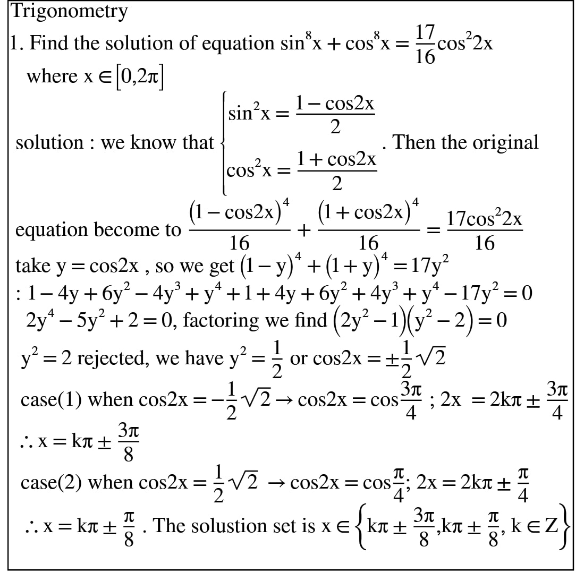
Commented by mr W last updated on 10/Jul/21
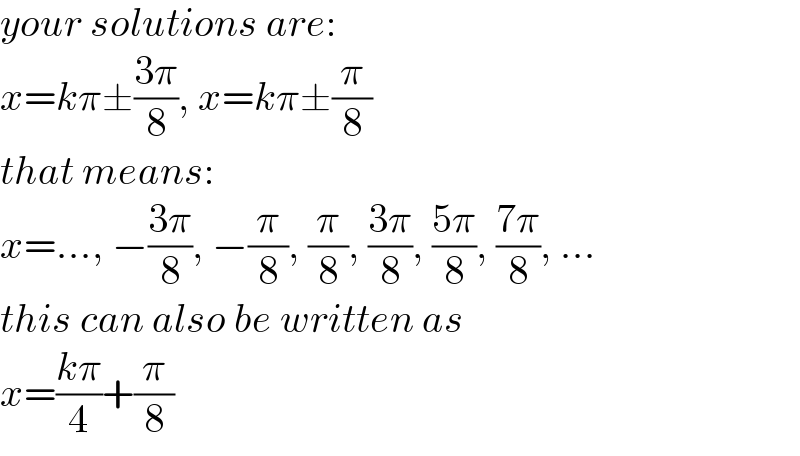
$${your}\:{solutions}\:{are}: \\ $$$${x}={k}\pi\pm\frac{\mathrm{3}\pi}{\mathrm{8}},\:{x}={k}\pi\pm\frac{\pi}{\mathrm{8}} \\ $$$${that}\:{means}: \\ $$$${x}=...,\:−\frac{\mathrm{3}\pi}{\mathrm{8}},\:−\frac{\pi}{\mathrm{8}},\:\frac{\pi}{\mathrm{8}},\:\frac{\mathrm{3}\pi}{\mathrm{8}},\:\frac{\mathrm{5}\pi}{\mathrm{8}},\:\frac{\mathrm{7}\pi}{\mathrm{8}},\:... \\ $$$${this}\:{can}\:{also}\:{be}\:{written}\:{as} \\ $$$${x}=\frac{{k}\pi}{\mathrm{4}}+\frac{\pi}{\mathrm{8}} \\ $$
Answered by mr W last updated on 09/Jul/21
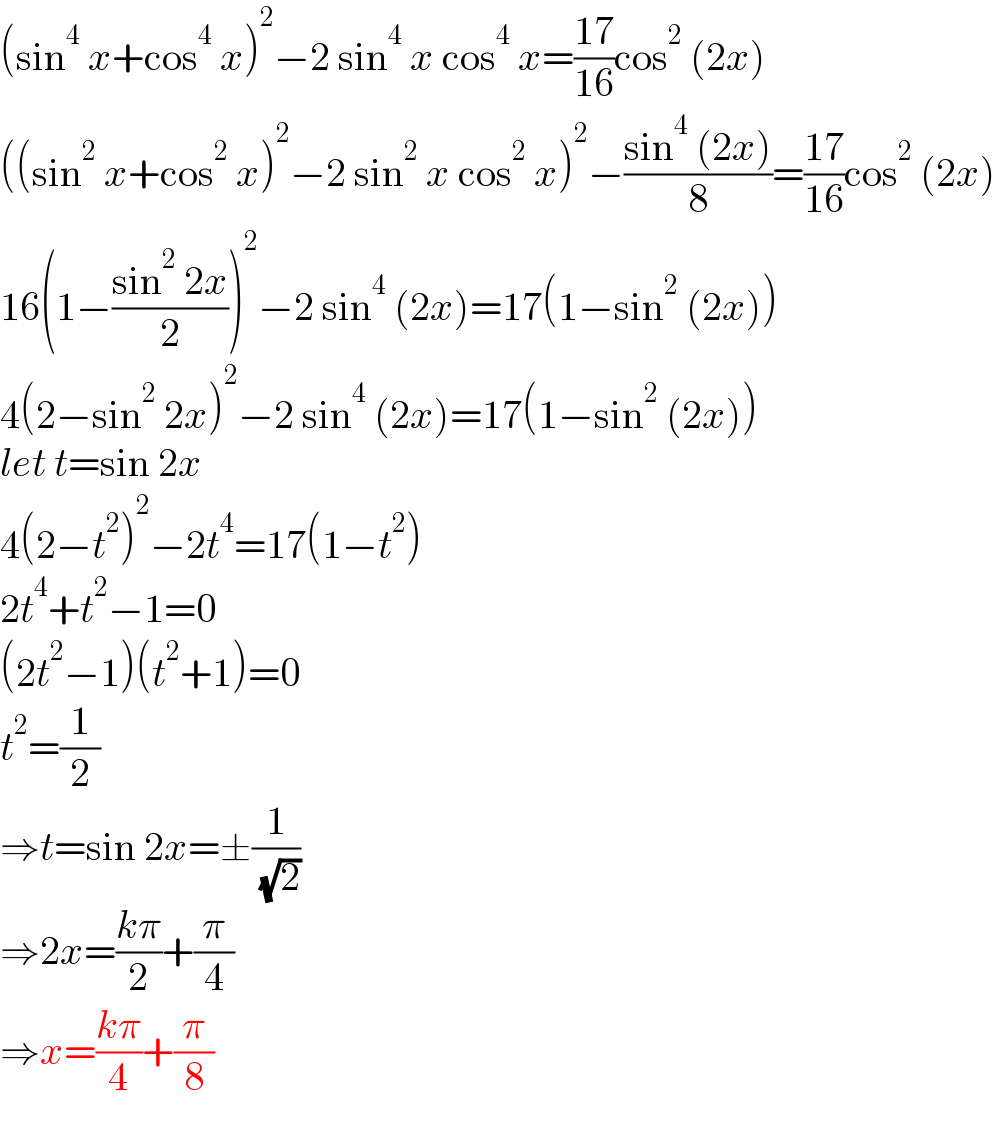
$$\left(\mathrm{sin}^{\mathrm{4}} \:{x}+\mathrm{cos}^{\mathrm{4}} \:{x}\right)^{\mathrm{2}} −\mathrm{2}\:\mathrm{sin}^{\mathrm{4}} \:{x}\:\mathrm{cos}^{\mathrm{4}} \:{x}=\frac{\mathrm{17}}{\mathrm{16}}\mathrm{cos}^{\mathrm{2}} \:\left(\mathrm{2}{x}\right) \\ $$$$\left(\left(\mathrm{sin}^{\mathrm{2}} \:{x}+\mathrm{cos}^{\mathrm{2}} \:{x}\right)^{\mathrm{2}} −\mathrm{2}\:\mathrm{sin}^{\mathrm{2}} \:{x}\:\mathrm{cos}^{\mathrm{2}} \:{x}\right)^{\mathrm{2}} −\frac{\mathrm{sin}^{\mathrm{4}} \:\left(\mathrm{2}{x}\right)}{\mathrm{8}}=\frac{\mathrm{17}}{\mathrm{16}}\mathrm{cos}^{\mathrm{2}} \:\left(\mathrm{2}{x}\right) \\ $$$$\mathrm{16}\left(\mathrm{1}−\frac{\mathrm{sin}^{\mathrm{2}} \:\mathrm{2}{x}}{\mathrm{2}}\right)^{\mathrm{2}} −\mathrm{2}\:\mathrm{sin}^{\mathrm{4}} \:\left(\mathrm{2}{x}\right)=\mathrm{17}\left(\mathrm{1}−\mathrm{sin}^{\mathrm{2}} \:\left(\mathrm{2}{x}\right)\right) \\ $$$$\mathrm{4}\left(\mathrm{2}−\mathrm{sin}^{\mathrm{2}} \:\mathrm{2}{x}\right)^{\mathrm{2}} −\mathrm{2}\:\mathrm{sin}^{\mathrm{4}} \:\left(\mathrm{2}{x}\right)=\mathrm{17}\left(\mathrm{1}−\mathrm{sin}^{\mathrm{2}} \:\left(\mathrm{2}{x}\right)\right) \\ $$$${let}\:{t}=\mathrm{sin}\:\mathrm{2}{x} \\ $$$$\mathrm{4}\left(\mathrm{2}−{t}^{\mathrm{2}} \right)^{\mathrm{2}} −\mathrm{2}{t}^{\mathrm{4}} =\mathrm{17}\left(\mathrm{1}−{t}^{\mathrm{2}} \right) \\ $$$$\mathrm{2}{t}^{\mathrm{4}} +{t}^{\mathrm{2}} −\mathrm{1}=\mathrm{0} \\ $$$$\left(\mathrm{2}{t}^{\mathrm{2}} −\mathrm{1}\right)\left({t}^{\mathrm{2}} +\mathrm{1}\right)=\mathrm{0} \\ $$$${t}^{\mathrm{2}} =\frac{\mathrm{1}}{\mathrm{2}} \\ $$$$\Rightarrow{t}=\mathrm{sin}\:\mathrm{2}{x}=\pm\frac{\mathrm{1}}{\:\sqrt{\mathrm{2}}} \\ $$$$\Rightarrow\mathrm{2}{x}=\frac{{k}\pi}{\mathrm{2}}+\frac{\pi}{\mathrm{4}} \\ $$$$\Rightarrow{x}=\frac{{k}\pi}{\mathrm{4}}+\frac{\pi}{\mathrm{8}} \\ $$
Commented by mr W last updated on 10/Jul/21
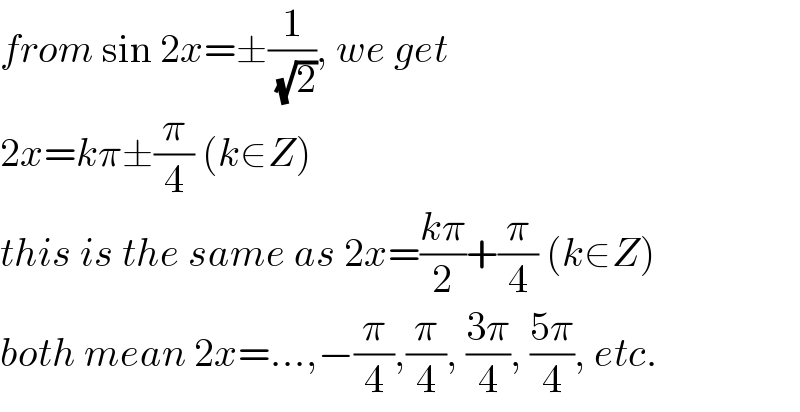
$${from}\:\mathrm{sin}\:\mathrm{2}{x}=\pm\frac{\mathrm{1}}{\:\sqrt{\mathrm{2}}},\:{we}\:{get} \\ $$$$\mathrm{2}{x}={k}\pi\pm\frac{\pi}{\mathrm{4}}\:\left({k}\in{Z}\right) \\ $$$${this}\:{is}\:{the}\:{same}\:{as}\:\mathrm{2}{x}=\frac{{k}\pi}{\mathrm{2}}+\frac{\pi}{\mathrm{4}}\:\left({k}\in{Z}\right) \\ $$$${both}\:{mean}\:\mathrm{2}{x}=...,−\frac{\pi}{\mathrm{4}},\frac{\pi}{\mathrm{4}},\:\frac{\mathrm{3}\pi}{\mathrm{4}},\:\frac{\mathrm{5}\pi}{\mathrm{4}},\:{etc}. \\ $$
Commented by mathdanisur last updated on 09/Jul/21

$${Cool}\:{Ser},\:{thank}\:{you} \\ $$
Commented by iloveisrael last updated on 10/Jul/21

$$\mathrm{why}\:\mathrm{sin}\:\mathrm{2x}\:=\:\pm\:\frac{\mathrm{1}}{\:\sqrt{\mathrm{2}}}\:\mathrm{then}\: \\ $$$$\:\mathrm{2x}=\frac{\mathrm{k}\pi}{\mathrm{2}}+\frac{\pi}{\mathrm{4}}\:?\:\mathrm{not}\:\mathrm{2x}\:=\:\mathrm{2k}\pi\:+\frac{\pi}{\mathrm{4}} \\ $$$$? \\ $$
Commented by iloveisrael last updated on 10/Jul/21

$$\mathrm{what}\:\mathrm{periodic}\:\mathrm{of}\:\mathrm{sin}\:\mathrm{function} \\ $$$$\mathrm{2}\pi\:\mathrm{or}\:\pi\: \\ $$$$\mathrm{it}\:\mathrm{should}\:\mathrm{be}\:\:\mathrm{2x}\:=\mathrm{2k}\pi\:\pm\:\frac{\pi}{\mathrm{4}} \\ $$$$\mathrm{then}\:\mathrm{x}\:=\:\mathrm{k}\pi\:\pm\:\frac{\pi}{\mathrm{8}}\: \\ $$
Commented by mr W last updated on 10/Jul/21
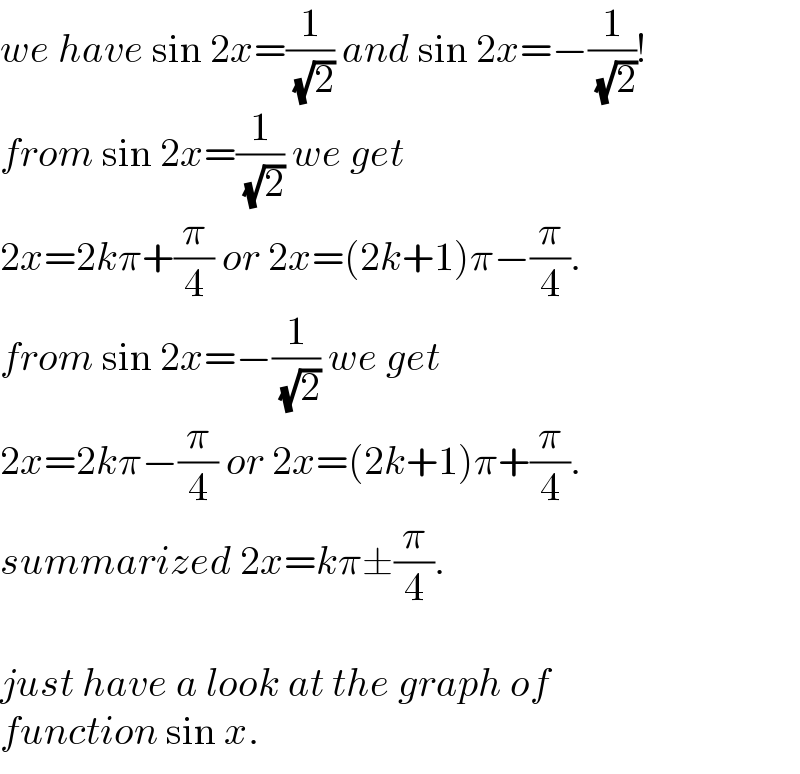
$${we}\:{have}\:\mathrm{sin}\:\mathrm{2}{x}=\frac{\mathrm{1}}{\:\sqrt{\mathrm{2}}}\:{and}\:\mathrm{sin}\:\mathrm{2}{x}=−\frac{\mathrm{1}}{\:\sqrt{\mathrm{2}}}! \\ $$$${from}\:\mathrm{sin}\:\mathrm{2}{x}=\frac{\mathrm{1}}{\:\sqrt{\mathrm{2}}}\:{we}\:{get} \\ $$$$\mathrm{2}{x}=\mathrm{2}{k}\pi+\frac{\pi}{\mathrm{4}}\:{or}\:\mathrm{2}{x}=\left(\mathrm{2}{k}+\mathrm{1}\right)\pi−\frac{\pi}{\mathrm{4}}. \\ $$$${from}\:\mathrm{sin}\:\mathrm{2}{x}=−\frac{\mathrm{1}}{\:\sqrt{\mathrm{2}}}\:{we}\:{get} \\ $$$$\mathrm{2}{x}=\mathrm{2}{k}\pi−\frac{\pi}{\mathrm{4}}\:{or}\:\mathrm{2}{x}=\left(\mathrm{2}{k}+\mathrm{1}\right)\pi+\frac{\pi}{\mathrm{4}}. \\ $$$${summarized}\:\mathrm{2}{x}={k}\pi\pm\frac{\pi}{\mathrm{4}}. \\ $$$$ \\ $$$${just}\:{have}\:{a}\:{look}\:{at}\:{the}\:{graph}\:{of} \\ $$$${function}\:\mathrm{sin}\:{x}. \\ $$
